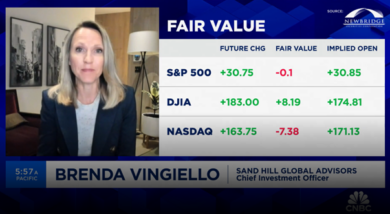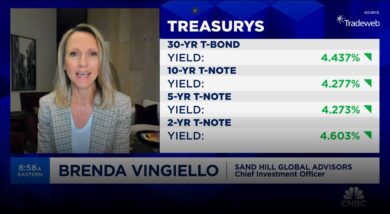Sand Hill's Chief Investment Officer, Brenda Vingiello, CFA, joins Jenny Harrington on “Halftime Report” to go over their most recent portfolio moves. Brenda's commentary begins

Market Update from Sand Hill Global Advisors | February 15, 2016
- The Chinese Economy: China, as the world’s second largest economy, has a significant impact on the world’s growth rate. Following years of extraordinary growth, the law-of-large numbers -combined with China’s widely-cited transition from a manufacturing-led economy to a consumption-led economy – has finally caused a substantial slowdown in the country’s headline growth rate. Complicating matters, China’s currency, which has historically been locked in a quasi-fixed exchange rate to the U.S. dollar, has appreciated significantly over the last year. This had created an overvalued Chinese currency, higher cost Chinese goods and a slower Chinese export economy. This in turn has resulted in several currency devaluations, leading to market dislocations and further slowing of global growth – a cycle that is likely to continue until our two currencies find a comfortable resting relationship in the coming year.
- Commodity Price Weakness: Meanwhile, China’s slowing demand for commodities, combined with OPEC’s deliberate oversupply tactics, has resulted in a dramatic fall in the price of oil over the last year. Historically, a pullback in oil was considered a ‘good thing’ as it led to improved consumer spending – as less money spent at the pump could find its way into other purchases. But not this time around. Technological advancements in drilling allowed the U.S. to access previously uneconomical oil reserves which led to the highest U.S. production levels in history. As oil prices fell, that reality acted as a countervailing economic weight, as energy and energy-related industries saw a drop in their corporate profitability; and many people in the industry lost their jobs. Further complicating matters in this sector, when oil falls a little bit, it’s considered a potential ‘tax cut’ to consumers. When it goes down a lot and it goes down fast, it can become a balance sheet issue for the weakest companies in the oil patch – and that has led to some isolated distress in the high yield credit markets. Encouragingly, there is some evidence that the consumption benefits of lower priced oil are beginning to come into play – and that the associated credit market stress is both isolated and quite possibly, overly pessimistic.
- The Federal Reserve: Finally, in the midst of slowing worldwide economic growth, falling commodity prices and little to no evidence of sustained inflationary pressures, the Federal Reserve still began the process of normalizing interest rates late last year. The change in liquidity trends caused by this admittedly modest initial hike were amplified worldwide as the U.S. dollar strengthened in anticipation of the move, adding further pressure on the overvalued Chinese Yuan, slowing growth and contributing further to the price pressure in oil. While widely considered to be a policy mistake today, the Federal Reserve marginally tightened financial conditions, further adding to global growth concerns. Based on recent testimony, we expect the Federal Reserve to effectively go on hold at their upcoming March meeting.
Articles and Commentary
Information provided in written articles are for informational purposes only and should not be considered investment advice. There is a risk of loss from investments in securities, including the risk of loss of principal. The information contained herein reflects Sand Hill Global Advisors' (“SHGA”) views as of the date of publication. Such views are subject to change at any time without notice due to changes in market or economic conditions and may not necessarily come to pass. SHGA does not provide tax or legal advice. To the extent that any material herein concerns tax or legal matters, such information is not intended to be solely relied upon nor used for the purpose of making tax and/or legal decisions without first seeking independent advice from a tax and/or legal professional. SHGA has obtained the information provided herein from various third party sources believed to be reliable but such information is not guaranteed. Certain links in this site connect to other websites maintained by third parties over whom SHGA has no control. SHGA makes no representations as to the accuracy or any other aspect of information contained in other Web Sites. Any forward looking statements or forecasts are based on assumptions and actual results are expected to vary from any such statements or forecasts. No reliance should be placed on any such statements or forecasts when making any investment decision. SHGA is not responsible for the consequences of any decisions or actions taken as a result of information provided in this presentation and does not warrant or guarantee the accuracy or completeness of this information. No part of this material may be (i) copied, photocopied, or duplicated in any form, by any means, or (ii) redistributed without the prior written consent of SHGA.
Video Presentations
All video presentations discuss certain investment products and/or securities and are being provided for informational purposes only, and should not be considered, and is not, investment, financial planning, tax or legal advice; nor is it a recommendation to buy or sell any securities. Investing in securities involves varying degrees of risk, and there can be no assurance that any specific investment will be profitable or suitable for a particular client’s financial situation or risk tolerance. Past performance is not a guarantee of future returns. Individual performance results will vary. The opinions expressed in the video reflect Sand Hill Global Advisor’s (“SHGA”) or Brenda Vingiello’s (as applicable) views as of the date of the video. Such views are subject to change at any point without notice. Any comments, opinions, or recommendations made by any host or other guest not affiliated with SHGA in this video do not necessarily reflect the views of SHGA, and non-SHGA persons appearing in this video do not fall under the supervisory purview of SHGA. You should not treat any opinion expressed by SHGA or Ms. Vingiello as a specific inducement to make a particular investment or follow a particular strategy, but only as an expression of general opinion. Nothing presented herein is or is intended to constitute investment advice, and no investment decision should be made based solely on any information provided on this video. There is a risk of loss from an investment in securities, including the risk of loss of principal. Neither SHGA nor Ms. Vingiello guarantees any specific outcome or profit. Any forward-looking statements or forecasts contained in the video are based on assumptions and actual results may vary from any such statements or forecasts. SHGA or one of its employees may have a position in the securities discussed and may purchase or sell such securities from time to time. Some of the information in this video has been obtained from third party sources. While SHGA believes such third-party information is reliable, SHGA does not guarantee its accuracy, timeliness or completeness. SHGA encourages you to consult with a professional financial advisor prior to making any investment decision.
Other Posts By This Author
- – A New Year’s Toast to the Silicon Valley Entrepreneur
- – How I Learned to Love the Bot
- – Thank You for Your Partnership
- – The Coming Deglobalization
Related Posts







